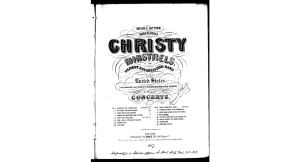Florence Price ((1887–1953) was an accomplished American composer, writing four symphonies and concertos, organ, chamber, and voice music. Her music and life tell a story of success but also hardship. One letter she wrote in particular speaks to the difficulties Price faced as a Black woman composing and publishing classical music. Price wrote to the conductor of the Boston Symphony, Serge Koussevitzky, to ask him to look over one of her symphonies and consider it for performance. This letter begins as follows,
“My Dear Dr. Koussevitzky, To begin with I have two handicaps— those of sex and race. I am a woman; and I have some Negro blood in my veins. Knowing the worst, then, would you be good enough to hold in check the possible inclination to regard a woman’s composition as long on emotionalism but short on virility and thought content;—until you shall have examined some of my work? As to the handicap of race, may I relieve you by saying that I neither expect nor ask any concession on that score. I should like to be judged on merit alone.”
What can we learn about Price and her music from this letter that we cannot get from other sources? This letter clearly delineates, in her own words, how racism and sexism affected Price. In an article on Price, which begins by analyzing this very letter, Samantha Ege states that “Price’s letter exemplifies the ways in which her desire to elevate her work on a prestigious platform, access this traditionally white male territory, and invest greater time in cultivating her craft was also controlled by what these ideas meant for a woman composer of African descent in early mid-twentieth-century America.”
To fully understand the influence and life of Price, this blog post would have to be a lot longer (probably book length). However, this short excerpt from one of her letters gives us a glimpse into the past, and enables us to better understand the present. I had never heard of Price until I got to college. In fact, as Ege also comments, there seems to be an assumption that women didn’t really compose before the 21st century, an assumption that is now slowly shifting due to cultural movements to diversify our understanding of musical history. In our discussions of what is “American music” it is always necessary to analyze the fact that our histories have purposefully written out those deemed to be “other”. This “othering” must continue to be challenged. As Ege writes,
“A commitment towards more diversified narratives can ensure that our present era affords women composers of the past—albeit posthumously—a much-deserved platform for their musical output and access, mobility, and agency in spheres that once excluded them from opportunity. Steps in this direction cannot change the circumstances experienced by such women, but recognize, at the very least, that for those who lived unapologetically and composed passionately, now is surely their time.”
To end this blog post I would like to suggest you go read Ege’s short article on Florence Price. She elegantly and much more comprehensively analyzes how Price’s music fits within the American musical canon, interwoven with a short biographical description of her life and works. The article will be linked below!
Citation
Ege, S. (2018). Florence Price and the Politics of Her Existence. The Kapralova Society Journal. http://www.kapralova.org/journal30.pdf
Peebles, S. L. (2008). The use of the spiritual in the piano works of two african american women composers—Florence B. price and margaret bonds (Order No. 3361197). Available from ProQuest Dissertations & Theses Global. (304528797). Retrieved from https://www.proquest.com/dissertations-theses/use-spiritual-piano-works-two-african-american/docview/304528797/se-2?accountid=351

